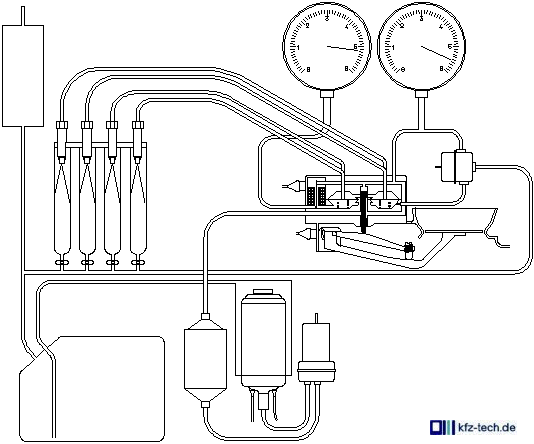|
|
KE-jetronic (test, diagnostic)

Function
The KE-Jetronic disappeared from vehicles too early to still participate in the blessings of modern times. Even though it was combined with the ignition, then known as Motronic, it never did however, receive a self-
diagnosing ability. It was, at any rate, a primarily hydro-mechanically regulated fuel injection system which was later connected, e.g., with a Lambda sensor. One could call it 'electronic impingement'.
How it works
The above figure shows a few of the testing possibilities. Of course, with this equipment, one can carry out, similar to a more modern multi-point fuel injection system, tests with lambda sensor tension and exhaust
gas, in much the same way as they are done, e.g., in an exhaust gas test. However, most tests showing discrepancies, refer to the pressure and the injection amount. One can check the latter, by causing the fuel
pump to run by bridging, and deflecting the air sensor plate no more than half the possible distance. The injection amount accumulated in the test tubes may differ, at very low deflection, by no more than max. 15%, at
a little more deflection, no more than 10%. If this is not the case, then corrosion and/or dirt in the fuel distributor can be assumed. Whoever now reaches for the tool-box, should be careful. Only the cylinder with the
control piston makes sense, and is to be carefully disassembled. If the upper- and lower half of the fuel distributor are separated from each other, it becomes difficult, even for professionals. The two large
manometers, refer to the system pressure on the right, and the control pressure on the left. The system pressure amounts, in the last-built equipment, to approx. 6 bar. However, it is much more important to observe
it, for hours or even days, after switching off the equipment. That's how long it normally holds a pressure of approx. 3 bar. If it does not react this way, hot starting difficulties are probable. The pressure difference
between the two is also important. If a rich mixture is required, e.g., by the Lambda control or when the engine is cold, this must rise, if a leaner mixture is required, this should sink to approx. 0.1 bar. If this is not the
case, and the Lambda sensor is intact, the hydro-electric pressure plate (the thicker of the two E-components in the mixture control system) is very likely defective. If the cold engine has problems with acceleration,
then the smaller of the two E-components in the mixture control system, is possibly defective, the data from the air sensor plate potentiometer, by the way, is only interesting for the control device, when the engine is
cold. 10/09
|
|